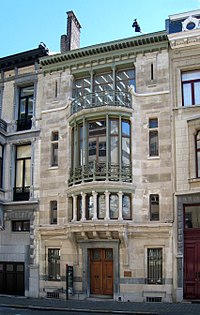Hotel Tassel
| Hôtel Tassel | |
|---|---|
| Hôtel Tassel (French) Hotel Tassel (Dutch) |
|
 |
|
| General information | |
| Architectural style | Art Nouveau |
| Location | Brussels, Belgium |
| Coordinates | 50°49′40″N 4°21′43.3″E / 50.82778°N 4.362028°ECoordinates: 50°49′40″N 4°21′43.3″E / 50.82778°N 4.362028°E |
| Construction started | 1893 |
| Completed | 1894 |
| Client | Emile Tassel |
| Design and construction | |
| Architect | Victor Horta |
| Official name | Major Town Houses of the Architect Victor Horta (Brussels) |
| Type | Cultural |
| Criteria | i, ii, iv |
| Designated | 2000 (24th session) |
| Reference no. | 1005 |
| State Party |
|
| Region | Europe and North America |
The Hotel Tassel (French: Hôtel Tassel, Dutch: Hotel Tassel) is a town house built by Victor Horta in Brussels for the Belgian scientist and professor Emile Tassel in 1893–1894. It is generally considered as the first true Art Nouveau building, because of its highly innovative plan and its groundbreaking use of materials and decoration. Together with three other town houses of Victor Horta, including Horta's own house and , it was put on the 'UNESCO World Heritage List' in 2000. It is located at 6, Rue Paul-Emile Jansonstraat in Brussels.
The first town house built by Victor Horta was the Maison Autrique. This dwelling was already innovative for its application of a novel 'Art Nouveau' decorative scheme that didn't include references to other historical styles. However the floor plan and spatial composition of the Maison Autrique remained rather traditional. On the deep and narrow building plot the rooms were organised according to a traditional scheme used in most Belgian town houses at that time. It consisted of a suite of rooms on the left side of the building plot flanked by a rather narrow entrance hall with stairs and a corridor that led to a small garden at the back. From the three room suite only the first and the last had windows so that the middle room (mostly used as a dining room) was rather gloomy.
At the Hôtel Tassel Horta definitively broke with this traditional scheme. In fact he built a house consisting of three different parts. Two rather conventional buildings in brick and natural stone — one on the side of the street and one on the side of the garden — were linked by a steel structure covered with glass. It functions as the connective part in the spatial composition of the house and contains staircases and landings that connect the different rooms and floors. Through the glass roof it functions as a light shaft that brings natural light into the centre of the building. In this part of the house, that could also be used for receiving guests, Horta made the maximum of his skills as an interior designer. He designed every single detail; doorhandles, woodwork, panels and windows in stained glass, mosaic flooring and the furnishing. Horta succeeded in integrating the lavish decoration without masking the general architectural structures.
...
Wikipedia
